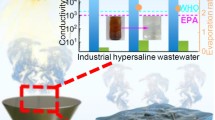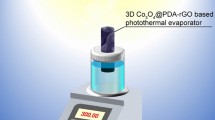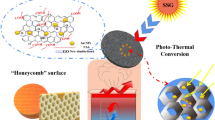Abstract
Solar-driven evaporation has been considered as one of the potential methods for desalination and sewage treatment. However, optical concentrators and complex multi-component systems are essential in advanced technologies, resulting in low efficiency and high cost. Here, we synthesize a reduced graphene oxide-based porous calcium alginate (CA-rGO) hydrogel which exhibits good performance in light absorption. More than 90% of the light in the whole spectrum can be absorbed. Meanwhile, the water vapor escapes from the CA-rGO film extremely fast. The water evaporation rate is 1.47 kg·m−2·h−1, corresponding to the efficiency 77% under only 1 kW·m−2 irradiation. The high evaporation efficiency is attributed to the distinctive structure of the film, which contains inherent porous structure of hydrogel enabling rapid water transport throughout the film, and the concave water surfaces formed in the hydrophilic pores provide a large surface area for evaporation. Hydrophobic rGO divides the evaporation surface and provides a longer three-phase evaporation line. The test on multiple cyclic radiation shows that the material has good stability. The CA-rGO hydrogel may have promising application as a membrane for solar steam generation in desalination and sewage treatment.
Similar content being viewed by others
References
Elimelech M, Phillip W A. The future of seawater desalination: Energy, technology, and the environment. Science, 2011, 333 (6043): 712–717
Sharma P R, Sharma S K, Lindström T, et al. Nanocelluloseenabled membranes for water purification: Perspectives. Advanced Sustainable Systems, 2020, 4(5): 1900114
Hillie T, Hlophe M. Nanotechnology and the challenge of clean water. Nature Nanotechnology, 2007, 2(11): 663–664
Wang L, Boutilier M S H, Kidambi P R, et al. Fundamental transport mechanisms, fabrication and potential applications of nanoporous atomically thin membranes. Nature Nanotechnology, 2017, 12(6): 509–522
Chu S, Cui Y, Liu N. The path towards sustainable energy. Nature Materials, 2017, 16(1): 16–22
Zhou L, Li X Q, Ni G W, et al. The revival of thermal utilization from the Sun: interfacial solar vapor generation. National Science Review, 2019, 6(3): 562–578
Lin Y, Xu H, Shan X L, et al. Solar steam generation based on the photothermal effect: from designs to applications, and beyond. Journal of Materials Chemistry A: Materials for Energy and Sustainability, 2019, 7(33): 19203–19227
Ni G, Zandavi S H, Javid S M, et al. A salt-rejecting floating solar still for low-cost desalination. Energy & Environmental Science, 2018, 11(6): 1510–1519
Li X Q, Lin R X, Ni G, et al. Three-dimensional artificial transpiration for efficient solar waste-water treatment. National Science Review, 2018, 5(1): 70–77
Li X Q, Min X Z, Li J L, et al. Storage and recycling of interfacial solar steam enthalpy. JOULE, 2018, 2(11): 2477–2484
Tao P, Ni G, Song C, et al. Solar-driven interfacial evaporation. Nature Energy, 2018, 3(12): 1031–1041
Liu G, Xu J, Wang K. Solar water evaporation by black photothermal sheets. Nano Energy, 2017, 41: 269–284
Wang P. Emerging investigator series: the rise of nano-enabled photothermal materials for water evaporation and clean water production by sunlight. Environmental Science: Nano, 2018, 5(5): 1078–1089
Zhang P, Liao Q, Yao H, et al. Direct solar steam generation system for clean water production. Energy Storage Materials, 2019, 18: 429–446
Zhao F, Zhou X, Shi Y, et al. Highly efficient solar vapour generation via hierarchically nanostructured gels. Nature Nanotechnology, 2018, 13(6): 489–495
Chen C, Li Y, Song J, et al. Highly flexible and efficient solar steam generation device. Advanced Materials, 2017, 29(30): 1701756
Gao X, Ren H, Zhou J, et al. Synthesis of hierarchical graphdiynebased architecture for efficient solar steam generation. Chemistry of Materials, 2017, 29(14): 5777–5781
Yang J, Pang Y, Huang W, et al. Functionalized graphene enables highly efficient solar thermal steam generation. ACS Nano, 2017, 11(6): 5510–5518
Wang G, Fu Y, Guo A, et al. Reduced graphene oxidepolyurethane nanocomposite foam as a reusable photoreceiver for efficient solar steam generation. Chemistry of Materials, 2017, 29(13): 5629–5635
Yang Y, Zhao R, Zhang T, et al. Graphene-based standalone solar energy converter for water desalination and purification. ACS Nano, 2018, 12(1): 829–835
Zhou L, Tan Y, Ji D, et al. Self-assembly of highly efficient, broadband plasmonic absorbers for solar steam generation. Science Advances, 2016, 2(4): e1501227
Fang J, Liu Q, Zhang W, et al. Ag/diatomite for highly efficient solar vapor generation under one-sun irradiation. Journal of Materials Chemistry A: Materials for Energy and Sustainability, 2017, 5(34): 17817–17821
Liu Y, Chen J, Guo D, et al. Floatable, self-cleaning, and carbon-black-based superhydrophobic gauze for the solar evaporation enhancement at the air-water interface. ACS Applied Materials & Interfaces, 2015, 7(24): 13645–13652
Zhang P, Li J, Lv L, et al. Vertically aligned graphene sheets membrane for highly efficient solar thermal generation of clean water. ACS Nano, 2017, 11(5): 5087–5093
Ren H, Tang M, Guan B, et al. Hierarchical graphene foam for efficient omnidirectional solar-thermal energy conversion. Advanced Materials, 2017, 29(38): 1702590
Hu X, Xu W, Zhou L, et al. Tailoring graphene oxide-based aerogels for efficient solar steam generation under one sun. Advanced Materials, 2017, 29(5): 1604031
Ito Y, Tanabe Y, Han J, et al. Multifunctional porous graphene for high-efficiency steam generation by heat localization. Advanced Materials, 2015, 27(29): 4302–4307
Wang X, He Y, Cheng G, et al. Direct vapor generation through localized solar heating via carbon-nanotube nanofluid. Energy Conversion and Management, 2016, 130: 176–183
Ni G, Miljkovic N, Ghasemi H, et al. Volumetric solar heating of nanofluids for direct vapor generation. Nano Energy, 2015, 17: 290–301
Yang Y, Que W, Zhao J, et al. Membrane assembled from antifouling copper-zinc-tin-selenide nanocarambolas for solar-driven interfacial water evaporation. Chemical Engineering Journal, 2019, 373: 955–962
Xu Y, Ma J, Liu D, et al. Origami system for efficient solar driven distillation in emergency water supply. Chemical Engineering Journal, 2019, 356: 869–876
Yang P, Liu K, Chen Q, et al. Solar-driven simultaneous steam production and electricity generation from salinity. Energy & Environmental Science, 2017, 10(9): 1923–1927
Zhou L, Tan Y, Wang J, et al. 3D self-assembly of aluminium nanoparticles for plasmon-enhanced solar desalination. Nature Photonics, 2016, 10(6): 393–398
Sajadi S M, Farokhnia N, Irajizad P, et al. Flexible artificially-networked structure for ambient-high pressure solar steam generation. Journal of Materials Chemistry A: Materials for Energy and Sustainability, 2016, 4(13): 4700–4705
Liu K K, Jiang Q, Tadepalli S, et al. Wood graphene oxide composite for highly efficient solar steam generation and desalination. ACS Applied Materials & Interfaces, 2017, 9(8): 7675–7681
Wang Z, Liu Y, Tao P, et al. Bio-inspired evaporation through plasmonic film of nanoparticles at the air-water interface. Small, 2014, 10(16): 3234–3239
Ghasemi H, Ni G, Marconnet A M, et al. Solar steam generation by heat localization. Nature Communications, 2014, 5(1): 4449
Li X, Xu W, Tang M, et al. Graphene oxide-based efficient and scalable solar desalination under one sun with a confined 2D water path. Proceedings of the National Academy of Sciences of the United States of America, 2016, 113(49): 13953–13958
Shan X, Lin Y, Zhao A, et al. Porous reduced graphene oxide/nickel foam for highly efficient solar steam generation. Nanotechnology, 2019, 30(42): 425403
Shan X L, Zhao A Q, Lin Y W, et al. Low-cost, scalable, and reusable photothermal layers for highly efficient solar steam generation and versatile energy conversion. Advanced Sustainable Systems, 2020, 4(5): 1900153
Ni G, Li G, Boriskina S V, et al. Steam generation under one sun enabled by a floating structure with thermal concentration. Nature Energy, 2016, 1(9): 16126
Finnerty C, Zhang L, Sedlak D L, et al. Synthetic graphene oxide leaf for solar desalination with zero liquid discharge. Environmental Science & Technology, 2017, 51(20): 11701–11709
Martinsen A, Skjåk-Braek G, Smidsrød O. Alginate as immobilization material: I. Correlation between chemical and physical properties of alginate gel beads. Biotechnology and Bioengineering, 1989, 33(1): 79–89
Martinsen A, Storrø I, Skjårk-Braek G. Alginate as immobilization material: III. Diffusional properties. Biotechnology and Bioengineering, 1992, 39(2): 186–194
Amsden B, Turner N. Diffusion characteristics of calcium alginate gels. Biotechnology and Bioengineering, 1999, 65(5): 605–610
Wendt D, Jakob M, Martin I. Bioreactor-based engineering of osteochondral grafts: from model systems to tissue manufacturing. Journal of Bioscience and Bioengineering, 2005, 100(5): 489–494
Schneider A, Francius G, Obeid R, et al. Polyelectrolyte multilayers with a tunable Young’s modulus: Influence of film stiffness on cell adhesion. Langmuir, 2006, 22(3): 1193–1200
Novoselov K S, Geim A K, Morozov S V, et al. Electric field effect in atomically thin carbon films. Science, 2004, 306(5696): 666–669
Singh V, Joung D, Zhai L, et al. Graphene based materials: Past, present and future. Progress in Materials Science, 2011, 56(8): 1178–1271
Park S, Ruoff R S. Chemical methods for the production of graphenes. Nature Nanotechnology, 2009, 4(4): 217–224
Zhu Y, Murali S, Cai W, et al. Graphene and graphene oxide: Synthesis, properties, and applications. Advanced Materials, 2010, 22(35): 3906–3924
Chen D, Feng H, Li J. Graphene oxide: preparation, functionalization, and electrochemical applications. Chemical Reviews, 2012, 112(11): 6027–6053
Zheng X, Jia B, Lin H, et al. Highly efficient and ultra-broadband graphene oxide ultrathin lenses with three-dimensional subwavelength focusing. Nature Communications, 2015, 6(1): 8433
Jiang X F, Polavarapu L, Neo S T, et al. Graphene oxides as tunable broadband nonlinear optical materials for femtosecond laser pulses. The Journal of Physical Chemistry Letters, 2012, 3(6): 785–790
Boukhvalov D W, Katsnelson M I, Son Y W. Origin of anomalous water permeation through graphene oxide membrane. Nano Letters, 2013, 13(8): 3930–3935
Nair R R, Wu H A, Jayaram P N, et al. Unimpeded permeation of water through helium-leak-tight graphene-based membranes. Science, 2012, 335(6067): 442–444
Kim H W, Yoon H W, Yoon S M, et al. Selective gas transport through few-layered graphene and graphene oxide membranes. Science, 2013, 342(6154): 91–95
Li H, Song Z, Zhang X, et al. Ultrathin, molecular-sieving graphene oxide membranes for selective hydrogen separation. Science, 2013, 342(6154): 95–98
Sun P, Zhu M, Wang K, et al. Selective ion penetration of graphene oxide membranes. ACS Nano, 2013, 7(1): 428–437
Joshi R K, Carbone P, Wang F C, et al. Precise and ultrafast molecular sieving through graphene oxide membranes. Science, 2014, 343(6172): 752–754
Mi B. Graphene oxide membranes for ionic and molecular sieving. Science, 2014, 343(6172): 740–742
Renteria J D, Ramirez S, Malekpour H, et al. Strongly anisotropic thermal conductivity of free-standing reduced graphene oxide films annealed at high temperature. Advanced Functional Materials, 2015, 25(29): 4664–4672
Tian L, Anilkumar P, Cao L, et al. Graphene oxides dispersing and hosting graphene sheets for unique nanocomposite materials. ACS Nano, 2011, 5(4): 3052–3058
Rogers R R, Yau M K. A Short Course in Cloud Physics. 3rd ed. Elsevier Science, 1989, 16
Adediji A, Ajibade L T. Quality of well water in Ede Area, southwestern Nigeria. Journal of Human Ecology, 2005, 17(3): 223–228
Iqbal H, Ishfaq M, Jabbar A, et al. Physico-chemical analysis of drinking water in district Kohat, Khyber Pakhtunkhwa, Pakistan. International Journal of Basic Medical Sciences and Pharmacy, 2013, 3(2): 37–41
Acknowledgements
This work was supported partly by the Zhejiang Provincial Natural Science Foundation of China (No. R21A020001), the National Natural Science Foundation of China (Grant No. 11774313), and the College Fund of Physics and Electronic Information Engineering of ZJNU (No. YS128X2001). J.K. was supported by the Start-up Fund of Zhejiang Normal University.
Author information
Authors and Affiliations
Corresponding authors
Additional information
Disclosure of potential conflicts of interests
The authors declare no competing financial interest.
Electronic supplementary material
Supplementary material, approximately 304 KB
Rights and permissions
About this article
Cite this article
Lou, G., Wang, Y., Ma, Y. et al. Reduced graphene oxide-based calcium alginate hydrogel as highly efficient solar steam generation membrane for desalination. Front. Mater. Sci. 15, 138–146 (2021). https://doi.org/10.1007/s11706-021-0536-x
Received:
Accepted:
Published:
Issue Date:
DOI: https://doi.org/10.1007/s11706-021-0536-x




